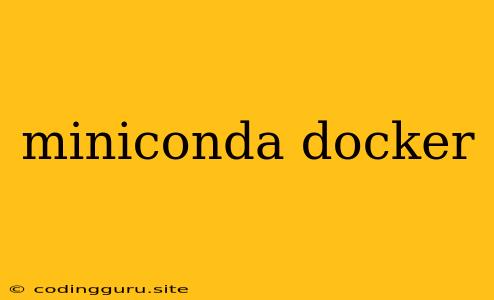Why Use Miniconda with Docker?
Docker and Miniconda are both powerful tools used in the realm of software development and data science. Combining these tools can enhance your workflow, offering significant advantages. Let's delve into the reasons why using Miniconda within a Docker environment is a winning combination.
What is Miniconda?
Miniconda is a lightweight version of the Anaconda distribution, specifically designed for managing Python environments. It's a streamlined package manager and environment manager for Python, providing a user-friendly interface to install, manage, and update various Python packages and their dependencies.
What is Docker?
Docker is a platform for building, running, and managing containerized applications. Containers are lightweight, self-contained units that encapsulate an application and its dependencies, ensuring consistency and portability across different environments.
The Power of Miniconda in a Docker Container
Here's where the synergy between Miniconda and Docker shines:
1. Reproducible Environments:
- Imagine you're working on a project requiring a specific set of Python packages and their exact versions. You need to ensure that anyone collaborating on the project can seamlessly replicate your environment without any compatibility issues.
- Miniconda within Docker solves this. You can create a Dockerfile that defines the exact Python version, Miniconda installation, and required packages. Building this Docker image creates a self-contained environment that can be run on any machine with Docker installed, guaranteeing consistency and eliminating dependency headaches.
2. Easy Collaboration and Sharing:
- Collaboration becomes a breeze. Share your Docker image with your team members, and everyone will have the same environment, eliminating "it works on my machine" frustrations.
- Docker images can be easily shared on Docker Hub, a public repository, making it effortless for others to access and use your project's environment.
3. Dependency Management Made Simple:
- One of the biggest challenges in software development is managing dependencies. Different libraries and projects may require different versions of Python, making conflicts inevitable.
- Miniconda within Docker isolates your project's dependencies within the container, preventing them from interfering with other projects on your system. This isolation also guarantees that you're always using the correct versions of packages, simplifying your workflow.
4. Isolating Environments:
- A single machine can host multiple Docker containers, each containing its own Miniconda environment. This isolation prevents package conflicts and ensures that your project is running in a clean, isolated environment.
5. Streamlined Deployment:
- When deploying your application, you can easily use the Docker image containing your Miniconda environment. This streamlined deployment process ensures that your application is packaged with all its dependencies, making the transition to production environments seamless.
Example
Let's see how to create a Dockerfile to use Miniconda:
FROM ubuntu:latest
# Install Miniconda
RUN wget -nv https://repo.anaconda.com/miniconda/Miniconda3-latest-Linux-x86_64.sh \
&& chmod +x Miniconda3-latest-Linux-x86_64.sh \
&& ./Miniconda3-latest-Linux-x86_64.sh -b -f -p /usr/local \
&& rm Miniconda3-latest-Linux-x86_64.sh
# Update and install packages
RUN conda update -y -c defaults conda \
&& conda install -y -c defaults python=3.9 \
&& conda install -y -c defaults numpy pandas matplotlib
# Set working directory
WORKDIR /app
# Copy your project files
COPY . /app
# Run your project's entry point
CMD ["python", "main.py"]
This Dockerfile:
- Starts with a base image:
ubuntu:latest - Downloads and installs Miniconda:
wget,chmod, and./Miniconda3-latest-Linux-x86_64.sh - Updates Miniconda and installs required packages:
conda update,conda install - Sets the working directory:
WORKDIR /app - Copies your project files:
COPY . /app - Runs your project's main script:
CMD ["python", "main.py"]
Building and running the Docker image:
docker build -t my-conda-app .
docker run -it my-conda-app
Conclusion
Combining Miniconda and Docker offers a powerful solution for developers and data scientists. The combination creates reproducible, portable, and isolated environments, streamlining your workflow and simplifying dependency management. Whether you're working on personal projects, collaborating with a team, or deploying applications, using Miniconda within a Docker container is a best practice that enhances your efficiency and reliability.
